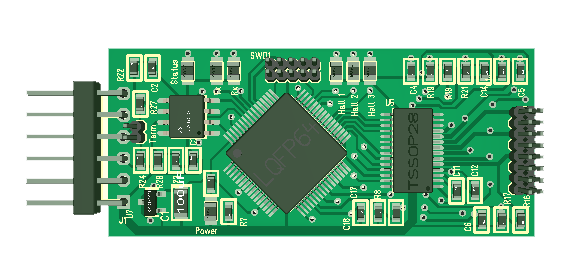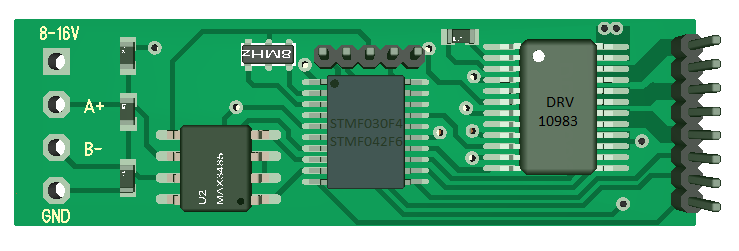If you search for schematics you will notice that DRV8313 is far more popular than DRV10983. DRV10983 only support 28V, while DRV8313 support 60V, but the most important difference is that DRV10983 needs to be programmed through I2C while DRV8313 have direct PWM per half H-Bridge.
The 3D model above show the DRV8301 based design using a STF32F105RB, while the DRV10983 using STM32F030F4 is shown below. The size of the the driver above is 50 x 20 mm, while the one below is 40 x 11 mm.
I initially started with DRV8313, but switched to the simpler DRV10983 which is working “ok” and support a very small size. I needed 9mm more to route DRV8313, but I also supported far more on the DRV8313 design and used a LQFP64 MCU package.
I never put the DRV8313 design into test, but I actually have a load of chips and want to make a new design based on this. I like the 60V capability and the capability to use the MCU to drive the motor, I also have loads of STM32F303CB MCU’s that cost < 2.- USD and is very optional as a Motor Controller.
Both these designs have a 2.5A limitation, but the cost of DRV8313 is ca 50% of DRV10983. I will continue both designs as I also plan an upgrade of the DRV10983. I do however need to get going on coding the I2C on this and convince myself that I can control the motor speed a bit better. Next PCB will also be simpler as I am replacing connectors and removing the separate PSU.
One huge advantage on DRV10983 is the 100mA 3.3V DC/DC converter. DRV8313 only support 10mA and that is to low for a MCU + Tranceiver, meaning that I will need to find a different PSU solution. I need a 60/3.3V DC/DC supporting 100mA. I can easily use LM2596HV that do this at 3A, but that alone will be larger than the controller.
Next focus will be to establish a DRV8313 on a smaller, but decent size, while I try to minimize DRV10983 even further. And believe me, these are small as they are now! The actual target is mA Level motors, so the 2.5A range is very cool.

